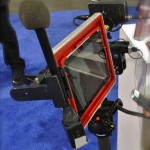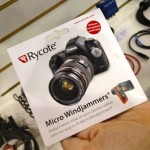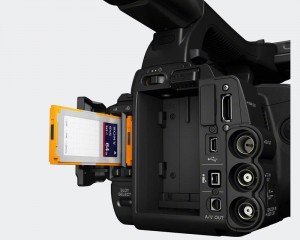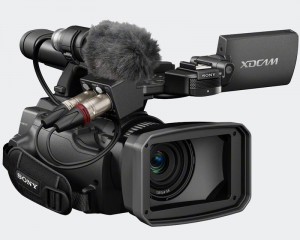Everything is going mobile, including video
The news ecosystem has suddenly gone mobile. Including video.
And I’m not sure the news producers realize it.
According to online advertising distributor BrightRoll, mobile video advertising will surpass online video advertising this year. Their CEO is quoted as saying that requests for mobile video ad exchanges have jumped from les than 5% to 40% of traffic in one year. And that mobile advertising requests overall have increased 4,000% in the past year.
The stats I’ve seen from my own paper also indicate an extremely rapid and across-the-board leap to mobile platforms for news consumption.
Even at the generally reactionary broadcast crowd at the NAB convention this year, a lot of talk was about ‘second screens’ and the way the audience are using their ipads and smart phones while watching broadcast TV.
“Stop thinking of producing stuff. Those days are over.” That was a comment from Michael Rosenblum on the NewspaperVideo email list as we talked about the switch to mobile.
But are those days over? YouTube is putting $100 million into producing original content.
Netflix generates by far the largest amount of internet traffic – as much as 30% and growing.
Online video advertising is setting records when connected to professionally-produced content on Hulu. “Delivering another record month, Hulu recorded more than 1.7 billion video ad views in March, while Google Sites — i.e., YouTube, ranked second with more than 1.2 billion video ads. The BrightRoll video network came in third with 953 million, followed by Adap.tv with 892 million, and Specific Media with more than 775 million.”
User-generated-content for media sites has been generally unsuccessful. It certainly has been at my paper and heavens knows we’ve tried. CNN has had some success with iReport, but they have dedicated resources to vetting the content and only review for publication a tiny fraction of ireports, and those are from news that is usually already making headlines. (See a fascinating master’s thesis on ireport and gatekeeping from Amani Channel here: http://scholarcommons.usf.edu/cgi/viewcontent.cgi?article=2597&context=etd )
For generations, our journalism model has been based on advertising paying the bills by surrounding the content. Even online, where advertising only generates pennies on the dollar compared to print, we’ve had a decent amount of success with all sorts of banners, flyouts, pre-rolls, sponsored pages, search-based ads, and individually targeted advertising. Some print media companies are making up to 50% of their revenue online.
But as things move to mobile, you lose some of the opportunity to surround your content with advertising. When the consumer is paying by the bit for their data, they’re going to object to too much advertising around the content they want to see. Mobile means 140 character stories, headlines, and links. On the video front, I’m guessing long form is out.
But how do we continue with advertiser-supported journalism on mobile devices? Stipends from the carriers? Sponsors on handsets and tablets?
Public-financed journalism? NPR is a shell of its former self; government funding has disappeared. The BBC ain’t doing so hot these days, either.
I don’t have a clue what the answer is. Just that things are changing. The wholesale jump to mobile consumption of news is an amazing and extraordinarily rapid change to our ecosystem. It doesn’t seem like many folks are talking about it but the traffic stats are really clear. Everything has changed on the news front. Our audience is now on smart phones.
How do we serve them? How do we survive?
(And I’m loving the debate on crowd-sourcing vs. gate-keeping. Just remember that Fox is the most popular news channel, Kony2012 is bunk, and your Facebook feed is full of hoaxes. And Hitler rose to power in a democratic republic.)
The PadCaster iPad rig
This is sick. A rig for an iPad to let you hook mics and lights on it – and even a 35mm adapter!
Josh Apter from the training company Manhattan Edit Workshops wanted a way to put stuff on his iPad and started building this contraption. It has a urethane insert that securely holds your iPad 3, inside an aluminum frame with 1/4-20 holes all around. You can mount it to a tripod and put mics and lights and stuff around the frame. And the wicked cool thing is the little mount so you can put your 35mm adapter on it. He was showing a quite nice movie he had shot with the rig – very impressive for an iPad.
It will sell for $200 and be available from www.thepadcaster.com
JVC GY-HM650 web and broadcast news cam
JVC is showing pre-production models of a news camera called the GY-HM650. This is a web-friendly broadcast-quality handy cam.
When it ships in December for $5695, it will have the ability to FTP from camera and be able to connect to wifi.
The magic here is that it has dual encoders that will let you record HD to one card and web-rez H.264 (among other codecs) to the other, and then send it out. But not live, unfortunately.
The HM650 does have both hdsdi and hdmi outputs so you can output live.
It’s got a 23X zoom with separate zoom, iris, and focus, and the camera has a decent grip. Big drawback seems to be small LCD and small EVF on the working HM600 they were showing. (HM600 lacks dual encoders and connectivity.)
This is a very interesting camera for news.
New video editing choices
I saw demos of two new editing programs last night that are pretty exciting.
First off is the new CS6 version of Adobe Premiere. This is an all-new version and it looks so much better than the previous one. It looks elegant and you mostly see your media now, instead of the program interface. It will take most any media and it has some cool features like skimming and live correction during playback, and great new trimming tools. This is where the old Final Cut desktop market will go, I think.
The other editing program is Autodesk Smoke 2013, which is targeted at the pro Final Cut market. It looks and acts like Final Cut when you’re in the editing mode but of course has the Smoke special effects engine behind it so you can make the film of your dreams – or nightmares, if you’re into horror. This makes After Effects look like a toy. Smoke used to be $15,000, but the new editing version will be much less – $3500. If you’re a pro editor it will be a bargain.
Avid, the broadcast standard, is running a special now to cross-grade from FCP to Avid Symphony 6 for $995. This too is a great bargain if you’re working in a collaborative environment. It’s normally $6,000. Just be prepared for the sticker shock for the next version upgrade.
The pro editing crowd is definitely not embracing Final Cut X and these new alternatives look good.
Black Magic Design $3k cinema camera
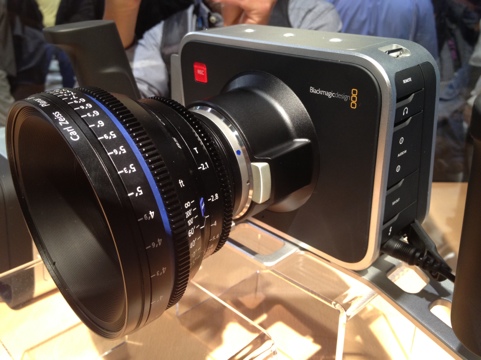
The Black Magic Design cinema camera is creating a huge buzz at NAB thanks to its low price of $2995.
It has only a Canon EF mount (not Nikon as erroneously put out in an early press release.) Mount is not interchangeable. Sensor is roughly Micro 4/3 size so your lens is doubled in focal length.
Has a 90 minute battery and a 12 volt input. Shoots avid dnxhd, prores and raw.
It’s cool but not a journalist’s camera.

Audio gear from NAB 2012 for DSLRS and for iPhones
I’m going to round up a bunch of audio discoveries I found at NAB 2012. Some for dslrs and some for iphones.
(UPDATE: Rode is not at the show and no one here has their new VideoMic HD recorder/microphone yet, so sorry, no info on that.)
DSLR audio stuff
Que Audio: First off, the video above is recorded into a Sony NEX7 with a Que Audio mic. This mic is very tiny and will fit into your camera bag along with the rest of your gear and still leave room for lunch. It’s a shotgun mic that’s about the size of a pen yet sounds pretty good. They are packaged in a variety of kits, from a bare-bones mic with shock mount on up to kits with booms and stands. The video was shot in a very noisy convention hall but the voice is still clear.
Rycote: Rycote has three items that news shooters will be interested in. First is a shock mount for your H4N or Tascam DR40 recorder so you can put it on top of your camera and reduce the handling noise. In the company photos the mount looks big but I’m pleased to report it’s not so big in real life.
The next Rycote goodie is their Invision Video shock mount. This is designed to hold shotgun microphones, but it will also clamp onto your Sennheiser MKE400 mic, even after you’ve broken the little shock mount on it. This mount is a great solution to those little rubber legs breaking off.
And finally, a must-have accessory for your DSLR or your iPhone is the Rycote micro windjammer, which is a little dot of furry wonder to cut the wind noise from your built-in mics on your camera or phone. These are semi-disposable, and stick on with a little circular pad to cover the mic. These work.
iPhone audio: This is a new subject for most manufacturers, but several iPhone audio solutions were at NAB. First was from Mic-W, a Beijing-based company making iPhone mics for mobile journalists and musicians. They have a range of shotguns and lavs that plug directly into an iPhone. The video above was recorded into an iPhone 4s with a Mic-W lavalier mic while he talked about a shotgun mic that plugs directly into an iPhone.
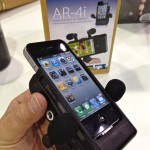 Fostex with the AR-4i has updated their microphone mount for iPhones so that it now works with an iPhone 4s – or at least that’s what the folks at Location Sound told me, as I didn’t get to try one. Your iPhone goes into this contraption and you get two external mics and a bunch of jacks.
Fostex with the AR-4i has updated their microphone mount for iPhones so that it now works with an iPhone 4s – or at least that’s what the folks at Location Sound told me, as I didn’t get to try one. Your iPhone goes into this contraption and you get two external mics and a bunch of jacks.
NAB report 2012
I’m in Vegas for the National Association of Broadcasters convention, where a few TV types worry about the state of the industry and the other 85,000 attendees drool over this year’s crop of new video and broadcast toys.
Two years ago the show was dominated by 3D products, with Sony’s giant booth darkened down so the crowd could don dorky glasses to watch 3D footage on a huge screen like the drones from Apple’s famous 1984 Mac ad. But the real action was in the booths where hordes of vendors were hawking accessories for DSLR cameras.
This year the buzz is all about 4k cameras, with new models from Canon and Sony sure to draw the multitudes. But like 3D, those cameras may be before their time. Normal folks have no way to display 4K let alone the horsepower to edit it.
We’ll see Monday morning when the displays open what the back story is for this year’s gear.
I’ll be posting stuff as I find it that is of interest to visual journalists.
Live streaming in the age of tapeless cameras

Livestream encoder
It used to be really easy to live stream an event – plug a firewire cable into your laptop from your dv camera and away your went.
But now with tapeless HD cameras, it’s not so easy. There’s no firewire port on most new cameras. And even if you’re using a firewire camera, the newer versions of Mac OS X and Flash have broken the audio part of the equation for those who are Mac-based.
Here are a few ways to get around the problems:
The analog/digital converter route – Using something like the Grass Valley ADVC55 Analog/Digital Converter, you can take the av output from your camera, (assuming you can remove the onscreen displays from within your camera menus,) and convert the video to firewire. Your camera’s av output is typically on a cable with red, white, and yellow RCA connectors, with the yellow being standard def analog video meant for a monitor. In theory, you can plug all three cables into your converter box and feed it into your laptop via firewire. In practice, you won’t get any audio with Livestream or UStream live broadcasting services. I don’t know if Flash or OS X is to blame, but you can’t get audio this way any longer. The solution is to use a mini stereo to RCA “Y” adapter and feed your audio straight into your Mac’s microphone jack (at Mic level only, not line.) Then set your Flash settings to use the DV box for video and ‘built-in input’ for audio. This is my method.
External encoder – using something like a Teradek Cube, or the newly-announced Livestream Broadcaster pictured above, or at the higher end a Newtek Tricaster, you can encode your signal and broadcast live. There’s even one called the Teradek Bond which uses multiple cell phone usb data cards to broadcast HD live. And if you have a large budget, you can get a LiveU.tv backpack to do live broadcast quality video.
But in any case, you live and die by your internet connection. I have never had success over a venue’s wifi at an event – a small crowd of people will take down the connection speed quickly. Hardwire ethernet connections to a separate internet leg is best, and a 4G cellular data puck will often work, unless it’s on ATT and there are a lot of iPhones in the crowd. Like I said, live-streaming isn’t as easy as it used to be.
UPDATE: Here’s another entry in the streaming field:
The MiniCaster is a camera-top box with various models that take in either HDSDI, HDMI, or analog signals and encode them in h.264 for web streaming. The German manufacturer has put it in a sturdy-feeling plastic case with weather sealing. It has a battery built-in with a relatively short life but has a power input from 8-24 volts. It has a usb port for a single cellular modem or wifi to connect to a hot spot. Prices range from $1500-$3,000 from resellers all over the world. This looks like something built ruggedly for news.
NAB is coming, so it’s new camera announcement time! Sony PMW100 XDCAM
The camera announcements are starting to spread like wildfire as the NAB convention in Las Vegas approaches. Yesterday we heard about Sony’s new FS700 camera which improves on their already-popular FS100 indie film camera.
Late last night, news from Sony on their new mini XDCAM PMW100 hit their Facebook page. This is a really exciting journalist’s camera.
UPDATE: Got to see this camera at the Sony booth at NAB. It’s much larger than it looks in the handout photos and is quite wide, so even though its smaller than an EX1, the packed for travel size is going to be about the same. Quite a bit bigger than a Canon XF100. However, it is lighter than an EX1 and easier to hand-hold.
It’s tiny, has a 10x zoom, full broadcast codec with HDSDI, genlock and timecode, uses SXS or SD cards, manual controls, xlr’s, and there’s even a firewire port on the back (and it will shoot in DVCAM, so maybe it’s even possible to livestream off it, but details are scant at the moment.)
This is a direct competitor to the JVC HM150 and Canon XF105 cameras. Supposed to be available in May at a list price of $4500.
Here’s the press release:
“PARK RIDGE, N.J., April 3, 2012 — Sony is introducing the full-featured yet light and compact PMW-100 handheld camcorder. The new PMW-100 joins Sony’s XDCAM HD422 line-up as the smallest and lightest camera in the XDCAM family.
“Advancements in digital imaging technology have enabled journalists and professional videographers to cover stories by using portable devices such as cell phones, DSLRs, and consumer camcorders,” said Tatsuro Kurachi, senior manager, Professional Solutions of America, Sony Electronics. “However, when compared to traditional shoulder-mount camcorders, there is still a significant gap in image quality, ease of editing, and data management. The PMW-100 achieves the best of both worlds, by recording full broadcast quality MPEG HD422 video within a hand-held form factor.”
Equipped with a newly developed 1/2.9-inch “Exmor” CMOS sensor, the camcorder delivers excellent picture performance and also achieves minimum illumination of 0.08lx. Featuring a 5.4-54mm (40-400mm in 35mm equivalent) zoom lens, the versatile PMW-100 allows users to work in virtually any production environment where mobility and flexibility is critical.
The PMW-100 combines exceptional picture fidelity with portability and outstanding manoeuvrability based on the proven XDCAM workflow, giving professional users a new level of productivity. The development of the PMW-100 is a natural step in the progression of the XDCAM line, and its development is in direct response to customer feedback for a light and compact camera that will not only perform well on its own, but also alongside other XDCAM cameras such as Sony’s PMW-500.
The PMW-100 supports full HD video at 1080i, 1080p and 720p up to 50 Mbps MXF record and playback based on the MPEG HD422 codec using the standard MPEG HD422 Long GOP compression technology. It is also switchable to MPEG HD420 35/25Mbps or even DVCAM 25Mbps recording, which similar options in the market do not offer. The PMW-100 can also record high quality 24-bit four-channel audio at uncompressed 48kHz, ideal for pairing with the new optional ECM-MS2 stereo microphone.
The camcorder offers a high level of flexibility using a variety of recording media including high speed SxS PRO memory card as well as Memory Stick, SD cards and XQD cards as an “emergency” secondary media. The new application software “SxS Memory Card Management Utility”* will provide additional operational convenience with SxS memory cards, such as data back-up functions and the life time indication of the card in use.
Focusing on a subject and reviewing recorded footage is simplified with the camcorder’s full color 3.5-inch WVGA (852×480) LCD, a much higher resolution than those found in other small handheld camcorders. The Slow & Quick Motion function lets users create artistic fast and slow-motion footage from 1 fps to 60 fps in 720p mode and from 1 fps to 30 fps in 1080p mode.
The camera also incorporates HD/SD-SDI output, Composite Out, Genlock input, time code in/out, i.LINK (HDV/DV) in/out, and A/V Out.
The PMW-100 XDCAM camcorder is planned to be available in May, with a suggested list price of $4,500.
* “SxS Memory Card Management Utility” will also be available via download in May.”


